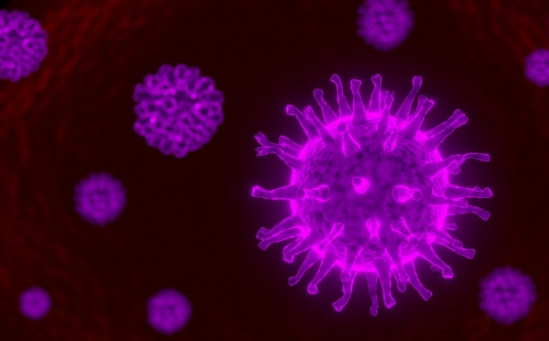Apr 15 2020
With the global population reeling under the impact of the COVID-19 pandemic, the world is primarily looking for ways to fight this novel coronavirus. That also includes the Solid State Lighting & Energy Electronics Center at the University of California, Santa Barbara (UC Santa Barbara) and member organizations.

Image Credit: University of California, Santa Barbara.
The scientists are creating ultraviolet (UV) LEDs that are capable of decontaminating surfaces—and possibly water and air—that have made contact with the SARS-CoV-2 virus.
One major application is in medical situations—the disinfection of personal protective equipment, surfaces, floors, within the HVAC systems, et cetera.
Christian Zollner, Doctoral Researcher, Department of Materials, University of California, Santa Barbara
Zollner’s study focuses on improving the deep UV light LED technology useful for purification and sanitation purposes. According to him, there is already a small market for UV-C disinfection products in the medical field.
To deactivate the novel coronavirus, the power of UV light has recently attracted a great deal of attention. The UV light disinfection technology has been in use for some time.
Although large-scale and practical efficacy against the infiltration of coronavirus has not been demonstrated yet, UV light has shown a great deal of promise. In early April, an SSLEEC member organization Seoul Semiconductor had reported a “99.9% sterilization of coronavirus (COVID-19) in 30 seconds” with its UV LED products.
The company’s technology is now being implemented for automotive use, especially in UV LED lamps that disinfect the interiors of unused vehicles.
But it should be noted that not all UV wavelengths are the same. Both UV-A and UV-B—the types of UV light that are abundantly received on Earth as a result of the Sun—have significant applications. However, the rare UV-C is the preferred UV light required for disinfecting water and air, and also for deactivating microorganisms. UV-C can only be produced through artificial processes.
UV-C light in the 260–285 nm range most relevant for current disinfection technologies is also harmful to human skin, so for now it is mostly used in applications where no one is present at the time of disinfection.
Christian Zollner, Doctoral Researcher, Department of Materials, University of California, Santa Barbara
The World Health Organization has warned against using UV disinfection lamps to disinfect various areas of the skin, including hands, because even minimal exposure to UV-C light can damage the eyes and may cause burns.
Even before the COVID-19 pandemic has received global attention, the SSLEEC materials researchers were already working on improving the UV-C LED technology.
For solid-state lighting, this region of the electromagnetic spectrum is a comparatively new frontier. More often, UV-C light is produced through mercury vapor lamps. Zollner further added that “many technological advances are needed for the UV LED to reach its potential in terms of efficiency, cost, reliability and lifetime.”
In a letter recently published in the ACS Photonics journal, the scientists reported a more sophisticated technique for developing high-quality deep-ultraviolet (UV-C) LEDs, In this method, a film of the semiconductor alloy, aluminum gallium nitride (AlGaN) is deposited on silicon carbide (SiC) substrate—instead of the sapphire substrate, which is more extensively used.
Zollner believes that instead of using sapphire, silicon carbide can be used as a substrate since it results in a cheaper and more cost-effective growth of high-quality UV-C semiconductor material. This is because the atomic structures of the materials match up quite closely, explained Zollner.
As a general rule of thumb, the more structurally similar (in terms of atomic crystal structure) the substrate and the film are to each other, the easier it is to achieve high material quality.
Christian Zollner, Doctoral Researcher, Department of Materials, University of California, Santa Barbara
Better quality will result in better performance and efficiency of the LED. Sapphire is known to be structurally dissimilar, and creating material without misalignments and defects typically needs complex additional steps. According to Zollner, though silicon carbide is not a perfect match, yet it results in a high-quality system without the requirement for additional and costly methods.
Silicon carbide is also relatively less costly than that of the “ideal” aluminum nitride substrate, rendering it more suitable for large-scale production, believes Zollner.
While the scientists were creating their UV-C LED technology, some of the major applications they considered were the fast-acting and portable water disinfection system. The reliability, durability, and small form factor of the diodes would be a game-changer in under-developed regions of the globe where there is a lack of clean water.
Now, another dimension has been added with the evolution of the COVID-19 pandemic. As the world strives to discover vaccines, cures, and therapies for the COVID-19 pandemic, decontamination, disinfection, and isolation are some of the weapons with which individuals can defend themselves, and the solutions will have to be deployed around the world.
Apart from water sanitation purposes, UV-C light may also be incorporated into systems that switch on when no one is present, stated Zollner.
“This would provide a low-cost, chemical-free and convenient way to sanitize public, retail, personal and medical spaces,” he added.
But for the moment, it is a game of patience, as Zollner and collaborators wait out the COVID-19 pandemic. Studies at UC Santa Barbara have slowed down considerably to reduce person-to-person contact.
“Our next steps, once research activities resume at UCSB, is to continue our work on improving our AlGaN/SiC platform to hopefully produce the world’s most efficient UV-C light emitters,” Zollner concludes.
Other study contributors include Burhan K. SaifAddin (study’s lead author), Shuji Nakamura, Steven P. DenBaars, James S. Speck, Abdullah S. Almogbel, Bastien Bonef, Michael Iza, and Feng Wu, all from SSLEEC and/or the Department of Materials at UC Santa Barbara.